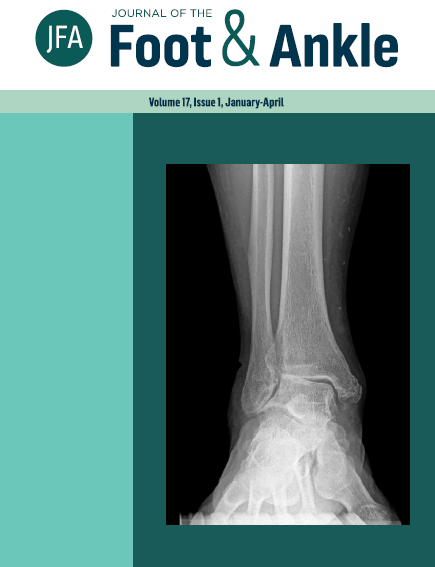Prevalence of ankle accessory muscles: a cross-sectional study
DOI:
https://doi.org/10.30795/jfootankle.2023.v17.1687Keywords:
Ankle joint; Magnetic resonance imaging; Muscle, skeletal; Tendons.Abstract
Objective: Determine the prevalence of accessory muscles around the ankle of patients with ankle pain using magnetic resonance imaging (MRI) and evaluate its correlation with other foot and ankle disorders. In addition, better understand the association with accessory muscle and types of pain, mechanical due to compression forces around ankle structures or neuropathic due to mass effect around the tarsal tunnel. Methods: The MRIs obtained from 2007 to 2017 were retrospectively studied and analyzed by a radiologist specializing in foot and ankle pathologies. A total of 9,600 scans were studied after ankle pain; 31 scans had at least one accessory muscle. Results: The prevalence of symptomatic accessory muscle was 0.32% (31 feet). It was found due to mechanical pain in 45.2% of cases. It was considered an incidental finding in 32.3%. Tarsal syndrome was the main clinical presentation in 19.4%, and 16% had other causes of mechanical disorders: 10% with peroneal tendinitis, 3% with Achilles tendinopathy, and 3% with plantar fasciitis. The prevalence of accessory muscles was 35% of the flexor digitorum, 32% of the peroneus quartus, 19% of the fibulocalcaneus internus, 13% of the accessory soleus, and 6% of the tibiocalcaneus internus. Conclusion: Although rare, accessory muscles can contribute to ankle pain with various presentations that confound clinical diagnosis or even appear as incidental on MRI and should be considered in the management of ankle pain. Level of Evidence III; Therapeutic Studies; Retrospective cohort study.
Downloads
Published
How to Cite
Issue
Section
License
Copyright (c) 2023 Journal of the Foot & Ankle

This work is licensed under a Creative Commons Attribution-NonCommercial 4.0 International License.







